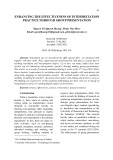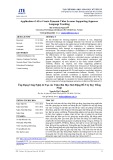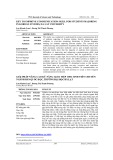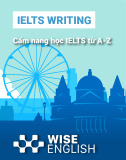
TNU Journal of Science and Technology 230(04): 212 - 220
http://jst.tnu.edu.vn 212 Email: jst@tnu.edu.vn
BRIDGING THE GAP FOR NON-ENGLISH MAJORS IN THE VSTEP
SPEAKING TEST: KEY CHALLENGES AND PRACTICAL SOLUTIONS
Le Thi Kim Duc
*
Ho Chi Minh City University of Economics and Finance
ARTICLE INFO ABSTRACT
Received:
02/01/2025
This research explores the difficulties encountered by non-
English major
students while getting ready for the VSTEP speaking t
est at a university in
Vietnam. A total of fifty-two intermediate-
level students, comprising 12
juniors and 40 seniors, took
part in a survey evaluating their views on the
test, challenges in preparation, and obstacles to performance. The results
indicate that students face difficulties due to inadequate speaking practice, a
shortage of resources, anxiety, and insufficient engagement with real-
life
communication situations. These obstacles affect their fluency, vocabulary,
and coherence while taking the test. Additionally, the research emphasizes
the perceived insufficiency of class time dedicated to speaking practice and
the lac
k of teacher support. According to these findings, the research
recommends various approaches to enhance student performance, such as
boosting speaking exercises in the classroom, supplying additional
resources, and delivering focused preparatory workshops. Digital resources
for independent practice and helpful feedback were recognized as crucial for
improving students' speaking abilities. The study highlights the significance
of thorough assistance in closing the disparity in language skills and
achieving improved results in the VSTEP speaking t
est for students not
majoring in English.
Revised:
31/3/2025
Published:
31/3/2025
KEYWORDS
VSTEP speaking test
Non-English majors
Language proficiency
Test challenges
Solutions and strategies
THU HẸP KHOẢNG CÁCH CHO SINH VIÊN KHÔNG CHUYÊN ANH TRONG
BÀI THI NÓI VSTEP: THÁCH THỨC CHÍNH VÀ GIẢI PHÁP THIẾT THỰC
Lê Thị Kim Đức
Trường Đại học Kinh tế Tài chính Thành phố Hồ Chí Minh
THÔNG TIN BÀI BÁO TÓM TẮT
Ngày nhận bài:
02/01/2025
Nghiên cứu này tìm hiểu những khó khăn mà sinh viên không chuyên tiế
ng
Anh gặp phải khi chuẩn bị cho kỳ thi nói VSTEP tại một trường đại học ở
Việt Nam. Tổng cộng có 52 sinh viên trình độ trung cấp, bao gồ
m 12 sinh
viên năm 3 và 40 sinh viên năm cuối, đã tham gia một cuộc khả
o sát đánh giá
quan điểm của họ về bài kiểm tra, những thách thức trong quá trình chuẩn bị
và những trở ngại đối với việc thực hiện. Kết quả chỉ ra rằng sinh viên gặ
p
khó khăn do luyện nói không đầy đủ, thiếu nguồn lực, lo lắ
ng và không tham
gia đầy đủ vào các tình huống giao tiếp thực tế. Những trở ngại này ả
nh
hưởng đến sự trôi chảy, từ vựng và sự mạch lạc của họ khi làm bài kiể
m tra.
Ngoài ra, nghiên cứu nhấn mạnh đến sự thiếu hụt thời gian trên lớ
p dành
riêng cho việc luyện nói và thiếu sự hỗ trợ của giáo viên. Theo những kết quả
này, nghiên cứu đề xuất nhiều cách tiếp cận khác nhau để
nâng cao thành
tích của học sinh, chẳng hạn như tăng cường các bài tập nói trong lớ
p, cung
cấp thêm tài nguyên và tổ chức các buổi hội thảo chuẩn bị tậ
p trung. Các
nguồn tài nguyên kỹ thuật số để thực hành độc lập và phản hồi hữu ích đượ
c
công nhận là rất quan trọng trong việc cải thiện khả năng nói của họ
c sinh.
Nghiên cứu nhấn mạnh tầm quan trọng của việc hỗ trợ toàn diện trong việ
c
thu hẹp sự chênh lệch về kỹ năng ngôn ngữ và cải thiện kết quả trong kỳ
thi
n
ói VSTEP cho sinh viên không h
ọ
c chuyên ngành ti
ế
ng Anh.
Ngày hoàn thiệ
n:
31/3/2025
Ngày đăng:
31/3/2025
TỪ KHÓA
Bài thi nói VSTEP
Sinh viên không chuyên Anh
Năng lực ngôn ngữ
Thách thức khi thi
Giải pháp và chiến lược
DOI: https://doi.org/10.34238/tnu-jst.11799
Email: ducltk@uef.edu.vn

TNU Journal of Science and Technology 230(04): 212 - 220
http://jst.tnu.edu.vn 213 Email: jst@tnu.edu.vn
1. Introduction
The VSTEP (Vietnamese Standardized Test of English Proficiency) has become an important
standard for evaluating English language skills in Vietnam, especially for students who are not
majoring in English. With universities progressively incorporating VSTEP into their language
assessment frameworks, it is crucial to comprehend the unique challenges these students face to
create effective teaching methods. The VSTEP speaking test specifically aims to assess students'
communicative abilities, including fluency, coherence, and precision in spoken English.
Nonetheless, students who are not majoring in English frequently feel unprepared for the
requirements of the exam, resulting in increased anxiety and less than ideal performance.
Significance of the VSTEP speaking test
The VSTEP speaking test is in accordance with the CEFR (Common European Framework of
Reference for Languages) standards, focusing on evaluating learners' real-world communication
abilities at different proficiency levels. Studies show that this test format prioritizes natural and
contextually suitable language use, representing a notable change from conventional assessment
approaches that mainly concentrate on grammar and lexicon [1]. Students who are not majoring
in English frequently miss out on immersive language experiences, essential for enhancing
speaking skills. This lack results in issues like restricted vocabulary, grammar mistakes, and
trouble with pronunciation, all of which adversely affect their speaking abilities [2].
Challenges faced by non-english majors
A significant challenge for students not majoring in English in the VSTEP speaking test is the
discrepancy between their educational background and the test's communication demands.
Numerous students encounter restricted opportunities for real speaking experiences, hindering
their capacity to perform well under stress [3]. Studies show that anxiety during speaking
evaluations frequently links to reduced performance levels [4]. Test anxiety greatly impacts the
speaking abilities of students who have limited practice in oral communication [5].
The structure of the VSTEP speaking test poses extra difficulties for students who are not
majoring in English, especially because it focuses on immediate interaction and the ability to
generate spontaneous responses. Numerous students find it challenging to maintain coherence
and fluency when under pressure, as they frequently are not used to the rigorous format of the
test. The demand for quick thinking and efficient communication techniques adds to the
complexity of their performance. Moreover, the absence of organized practice sessions and real-
life communication experiences worsens these challenges, causing students to feel ill-equipped
for the test's interactive format. Lacking adequate practice in impromptu speaking activities,
students might feel increased anxiety, resulting in hesitation and interrupted fluency. These
results underscore the importance of focused preparatory programs, such as organized speaking
exercises, immediate response practice, and tailored feedback, to assist students in acquiring the
essential skills for success in the VSTEP speaking test [6].
Proposed solutions and strategies
To tackle the challenges faced by non-English major students, researchers have proposed
multiple methods to enhance speaking abilities. Involving speaking activities like role-plays and
group discussions has been shown to improve fluency and decrease anxiety [7]. Applying these
methods in the classroom creates a more encouraging atmosphere for students to enhance their
speaking skills in a stress-free environment.
Moreover, technological progress offers creative possibilities for implementation. Utilizing
digital platforms, such as language learning apps and online speaking activities, provides learners
with adaptable, self-guided options to improve their speaking skills. These platforms generally
offer features like practice speaking tests and instant feedback, aiding students in acclimating to
the exam environment and enhancing their confidence [8].

TNU Journal of Science and Technology 230(04): 212 - 220
http://jst.tnu.edu.vn 214 Email: jst@tnu.edu.vn
In addition, specialized preparatory workshops designed for VSTEP-related activities can
more effectively prepare non-English majors with the necessary skills to succeed in the speaking
test. Workshops offering practice exams and personalized feedback greatly enhance students'
readiness and self-esteem [9].
In conclusion, the VSTEP speaking test poses substantial difficulties for students who are not
majoring in English, mainly because of their restricted exposure to engaging in language use.
Nonetheless, by implementing efficient teaching methods, using digital resources, and
participating in targeted preparatory tasks, teachers can close the language skills gap and help
students excel in their assessments.
2. Methodology
2.1. Settings and participants
This study was conducted at a university in Vietnam, involving 52 non-English major students
at the intermediate proficiency level. The participants comprised 12 junior students and 40 senior
students, reflecting a diverse range of academic experiences. The VSTEP speaking test, a critical
graduation requirement at the university, served as the focus of this research. Most of the
participants had completed six compulsory general English courses as part of their academic
curriculum, which provided them with foundational language skills but limited exposure to
communicative English practice. All participants had either just taken or previously experienced
the VSTEP speaking test, providing them with relevant insights into its structure and challenges.
This context highlights the importance of understanding students’ difficulties and experiences to
develop more targeted strategies for improving their speaking performance.
2.2. Procedures and data analysis
The research employed a structured survey to explore the challenges faced by non-English
major students in the VSTEP speaking test and their perceptions of the test. Data collection
focused on participants' year of study and self-reported English proficiency level (Section 1),
followed by an evaluation of the test's difficulty (Section 2), challenges encountered during
preparation (Section 3), and difficulties faced during the test itself (Section 4).
Sections 5 and 6 examined the underlying causes of these challenges and gathered student
suggestions for improving test preparation. Finally, open-ended questions in Section 7
allowed participants to provide detailed insights and recommendations for enhancing their
readiness for the test.
Descriptive statistics and frequency analysis in SPSS were used to examine the data in order
to identify important patterns in the responses of the students. Since the data was gathered using
an ordinal scale, which allows for the measurement of central tendency and variability, the mean
and standard deviation (SD) were computed for the perceived difficulty category. Since these
variables provide categorical data, frequency distributions and percentages were employed for the
remaining four categories (key challenges, emotional reactions, causes of difficulties, and
suggested solutions). This method allows for meaningful comparisons while guaranteeing that the
analysis truly reflects the experiences of the students. By highlighting the most frequently
mentioned issues and suggested fixes, percentages give a clearer picture of the main problems
that students encountered on the VSTEP speaking test.
To find recurrent themes in the students' open-ended responses, thematic analysis was used to
examine the qualitative data. Key issues that were the focus of the analysis were the perceived
difficulties faced by the students, their experiences preparing, and suggestions for improvement.
Meaningful topics including speaking practice, test anxiety, instructor assistance, vocabulary
challenges, and preparation materials were used to group the responses. This method enhanced the
quantitative results and offered more profound insights into the unique experiences of each student.

TNU Journal of Science and Technology 230(04): 212 - 220
http://jst.tnu.edu.vn 215 Email: jst@tnu.edu.vn
3. Findings and Discussion
3.1. Results
Table 1. Descriptive analysis of perceived difficulty in the VSTEP speaking test
Category
Mean
SD
Perceived
d
ifficulty
10.4
8.32
The analysis of students' perceptions of the VSTEP speaking test difficulty (Table 1) reveals a
mean score of 10.4 with a standard deviation of 8.32. This suggests that there was a significant
range in results, even though many students found the test difficult. While some students thought
the test was extremely challenging, others said it was easier to handle. The large SD indicates that
individuals' degrees of readiness varied, potentially as a result of their past exposure to and
practice with the English language. The comparatively large variance suggests that although
some students have adjusted to the test format effectively, others have a difficult time,
underscoring the need for more focused speaking practice and improved test-taking techniques.
Table 2. Difficulties encountered during speaking practice and frequency of practice
Category
Number of respondents
Percentage (%)
Challenges during independent practice
Lack
of resources
21
40.4
Difficulty in
identifying and correcting errors
34
65.4
Limited vocabulary
42
80.8
Lack of an English
-
speaking environment
26
50.0
Distractions while studying
21
40.4
Other
6
11.5
Frequency of speaking practice
Daily
13
25.0
Weekly
27
51.9
Monthly
4
7.7
Rarely
8
15.4
Never
0
0
Table 2 outlines the challenges participants faced while practicing independent speaking and
the regularity of their speaking practice. Regarding challenges, the predominant issue was
"Limited vocabulary," noted by 80.8% of participants, succeeded by "Difficulty in identifying and
correcting errors" (65.4%) and "Lack of an English-speaking environment" (50%). These elements
underline major obstacles in solo speaking practice, indicating a necessity for targeted vocabulary
enhancement and methods for correcting mistakes. Resource scarcity and interruptions during
study were noted by 40.4% of respondents, suggesting that outside influences also impede
efficient practice. A less percentage (11.5%) mentioned other unnamed difficulties.
In terms of speaking practice frequency, 51.9% of participants engaged in speaking activities
weekly, while 25.0% did so every day. 15.4% practiced infrequently, while 7.7% engaged in
practice on a monthly basis. The reality that a large percentage engages in speaking less
frequently than daily emphasizes a possible area for enhancement in their preparation practices.
These results highlight the importance of developing more accessible tools and encouraging
settings to improve independent speaking practice. Additionally, raising the frequency of
practice, particularly for individuals who engage in practice less often, may further enhance
proficiency in the VSTEP speaking test.
Table 3 displays the emotional reactions and difficulties encountered by students during the
VSTEP speaking test. Concerning emotions, 69.2% of participants indicated they felt "Nervous",
establishing it as the primary emotional state throughout the test. 44.2% experienced "Anxiety,"
while a less percentage of students reported feeling "Calm" (23.1%) or "Confident" (11.5%). Just
5.8% mentioned different emotions, showing that nervousness and anxiety were the predominant
reactions, implying the testing's high-stress character for numerous students. Regarding the

TNU Journal of Science and Technology 230(04): 212 - 220
http://jst.tnu.edu.vn 216 Email: jst@tnu.edu.vn
difficulties encountered during the examination, most students had trouble with selecting suitable
words (59.6%) and applying proper grammar (59.6%).
Table 3. Emotional responses and challenges encountered during the VSTEP speaking test
Category
Number of respondents
Percentage (%)
Emotions during the test
Nervous
36
69.2
Confident
6
11.5
Anxious
23
44.2
Calm
12
23.1
Other
3
5.8
Struggles during the test
Choosing appropriate words
31
59.6
Using correct grammar
31
59.6
Understanding the
examiner's questions
22
42.3
Expressing ideas smoothly
32
61.5
Managing time effectively
20
38.5
Other
5
9.6
Both of these challenges were equally common, emphasizing the struggle students encounter
in articulating themselves correctly and suitably when under stress. Moreover, 61.5% of those
surveyed indicated they faced difficulties with expressing ideas smoothly, suggesting issues with
fluency while taking the test. 42.3% faced difficulties with comprehending the examiner's
inquiries, while 38.5% reported challenges with utilizing time efficiently. A limited percentage
(9.6%) noted other vague difficulties. The results highlight the necessity for additional practice in
choosing vocabulary, ensuring grammatical precision, and enhancing fluency, along with
techniques to cope with test anxiety, comprehend questions better, and utilize time effectively
during the speaking examination.
Table 4. Causes of difficulties and perception of teacher’s support
Category
Number of respondents
Percentage (%)
Main causes of difficulties
Lack of
practice
32
61.5
Insufficient materials
28
53.8
Limited
class time for speaking practice
22
42.3
Lack of
teacher support
17
32.7
Other
8
15.4
Perception of teacher’s role
Very supportive
30
57.7
Somewhat supportive
19
36.5
Not supportive
2
3.8
Other
1
1.9
Table 4 examines the root causes of students' challenges and their views on teacher assistance
in getting ready for the VSTEP speaking test. The primary reason cited for difficulty was a "Lack
of practice," with 61.5% of participants recognizing it as an important factor. This implies that
students are not participating in enough speaking activities beyond the classroom. Subsequently,
53.8% of participants noted "Insufficient materials," emphasizing the demand for additional
resources designed for speaking practice. Restricted class duration for speaking practice was
noted by 42.3% of students, suggesting that time limitations in lessons could hinder
advancement. Insufficient teacher support was mentioned by 32.7%, whereas 15.4% referenced
alternative reasons, including personal issues or outside difficulties.
Concerning the perception of teacher assistance, most respondents (57.7%) viewed their
teachers as "very supportive," whereas 36.5% thought of them as "somewhat supportive." Just a
minor percentage considered their teachers to be "not supportive" (3.8%) or held alternative













![Tài liệu luyện thi TOEIC cấp tốc trong 10 ngày [chuẩn nhất]](https://cdn.tailieu.vn/images/document/thumbnail/2025/20251029/kimphuong1001/135x160/99661761725822.jpg)
![Tài liệu Phá đảo TOEIC 900+ từ mất gốc trong 30 ngày [Mới nhất]](https://cdn.tailieu.vn/images/document/thumbnail/2025/20251029/kimphuong1001/135x160/2101761720956.jpg)











